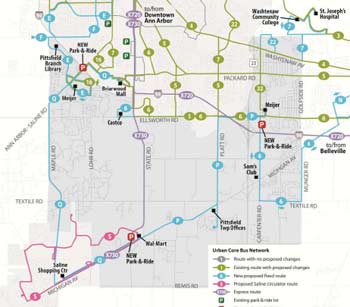The new sign for the Beer Depot is up and lit! It actually is good to see it back in service, looking all spruced up versus the character it had with the rust of the old sign. Definitely represents the character of that part of town! Yay!
Archive for March, 2013
A2: Old Diplomas
The Damn Arbor blog reports finding the diploma of a former Ann Arbor mayor while cleaning out the house of a grandparent. [Source]
413 E. Huron, Zoning Review: They’re Back
Ann Arbor city council meeting (March 18, 2013) Part 2: In a session that lasted until nearly 2 a.m., lengthy public commentary and council deliberations focused on two related items at the council’s last regular meeting: (1) a possible moratorium on D1 (downtown core) site plans; and (2) the site plan for 413 E. Huron, located in a D1 district. Both items resulted in some unfinished business that will need to be addressed at the council’s April 1 meeting.

Images for the proposed 413 E. Huron project, at the northeast corner of Huron and Division. On the left is the original rendering considered by the planning commission. On the right is an updated version presented to the city council on March 18, 2013. Even more revisions could be presented at the April 1 council meeting.
The council decided to conduct a review of D1 zoning, without imposing a moratorium. But councilmembers left some work on that issue until April 1, when the review’s clear scope of work and timeline are expected to be set.
The lack of any moratorium cleared the way to consider the 413 E. Huron project. Even though councilmembers deliberated in a fair amount of detail on the project, they still had a number of questions they wanted to pursue with the developer. So the council decided to postpone the item until April 1.
The council’s discussion of the 413 E. Huron project included a fine-grained examination of the project’s compliance with zoning code regarding the disturbance of natural features – trees in particular. It was punctuated by a resident shouting “You lie!” as the developer’s representative – Conor McNally of Atlanta-based Carter – responded to questions from councilmembers.
According to a letter sent by the developer to the council on March 29, councilmembers continued to submit additional questions in writing through March 28. That led to a request from the developer to remove the item from the April 1 agenda in favor of April 15, to allow for time to respond to questions. The developer is also hoping to revise 3D renderings to show changes in the building that have been made since March 18.
The developer’s request to pull the item from the agenda can’t be accommodated – because the council voted to postpone until a date certain, which means the item will need to appear on that April 1 agenda. To remove it would require a decision of the council, and that can’t be done administratively at the direction of the planning staff or on the initiative of the city clerk.
So the item will appear on the agenda, although the council may be inclined to make their deliberations brief, if their intent is to postpone it until April 15 – which would be consistent with the developer’s expressed preference. The public hearing on the site plan appears on the April 1 agenda as well, although it was declared closed by mayor John Hieftje on March 18.
This report includes a summary of public commentary and council deliberations on the moratorium and the 413 E. Huron site plan from March 18. A write-up of other agenda items is included in Part 1 of the March 18, 2013 meeting report. [Full Story]
Hunt Park
Respite stop for Ann Arbor marathon training. Hope the cups will be composted. [photo]
Washington & Second
Former road commission building at 415 W. Washington now bears sign reading “Renovation Yes, Demolition No!” Context is that Ann Arbor city council work session on March 25 included mention that the more likely outcome for the now vacant city-owned building is demolition. [photo] A nice shot of the whole facade from several years ago by Jim Rees: [Flickr]
Main & Liberty
Violin monster is out!
A2: Jim Cook
The Ann Arbor Rotary Club‘s blog highlights the service of Jim Cook, one of the club’s past presidents who recently received the group’s distinguished service award. His accomplishments include service on Rotary’s International Humanitarian Projects Committee, where he led major projects in the Philippines, India, Sri Lanka, Africa, and South and Central America. Cook has also served as a board member and chair of the Ann Arbor Art Center and Washtenaw Chapter of the Red Cross, and on the board of the Michigan Diabetes Association. [Source]
Washtenaw: Marriage Equality
Damn Arbor highlights the fact that Washtenaw County showed the largest increase in Facebook profile photo changes this week, using the red and pink “equal” sign to support marriage equality. The changes were analyzed by Eytan Bakshy on the Facebook Data Science Team. The Human Rights Campaign had urged Facebook users to change their profile photos on Monday, March 25, as the U.S. Supreme Court began debating two same-sex marriage cases. [Source]
W. Liberty near Alley Bar
“Indian Summer” painting by J.F. Cropsey part of Knight Foundation’s support for DIA’s Inside/Out.
Fifth & Ann
A framed reproduction of “Syria by the Sea” is hung on the side of Fire Station #1, on the outside wall facing the Ann Arbor Hands On Museum entrance. [photo] It’s one of seven installations in downtown Ann Arbor, part of the Detroit Institute of Arts’ Inside|Out program program.
UM: North Quad Flooding
The Michigan Daily provides an update and photos from the extensive flooding at North Quad, caused by a broken joint pipe in the building’s fire suppression system. The flooding affected student residences and classrooms – about 100 students were moved to other quarters. [Source]
Column: Michigan Hockey’s Consistency Streak
Sports columnist Rick Reilly once wrote that weekend golfers invariably claim, “I’m a good golfer. I’m just not consistent.”
Well, he said, if you’re not consistent, you’re not a good golfer.
Americans are great at building things, and rotten at maintaining them. We admire winners and celebrities, but we overlook the loyal spouse and the honest accountant and the people who maintain our bridges – and that’s why they’re falling apart.
So, let this be a salute to consistency – that most unheralded virtue.
In 1984, Red Berenson took over Michigan’s moribund hockey program, which had not been to the NCAA tournament in seven years. Berenson thought it would be easy, but it took seven more years to get Michigan hockey back to the big dance in 1991.
Once they got into the tournament, they made it a point to stay there. Year after year, they suffered heart-breaking tournament losses, but year after year, they kept coming back. Finally, in 1996, they won Michigan’s first national title in 32 years – and they did it again in 1998. They’ve come close a few times since, but they have yet to win another.
This bothers Berenson, one of the most competitive men I’ve ever met. When he visited my class, I introduced him by listing his many accomplishments on the board. When he stood up, the first thing he did was point to the two national titles on the board and say, “That’s not enough. We should have more.” [Full Story]
In the Archives: Michigan Merinos
Washtenaw County owes a long-forgotten debt to Napoleon Bonaparte.
In the chaos following Napoleon’s first invasion into Spain in the early 19th century, the Spanish crown lost control of a resource it had jealously guarded since its acquisition from the North African Berber people in the 11th century.
For centuries, Spanish royalty forbade this resource to leave the country, and Spain steadily accumulated wealth from the commodity it produced. One expenditure of this wealth funded a young Italian explorer on his 1492 journey to what he apparently expected would be India.
This possession was the royal flocks of merino sheep, and the commodity was arguably the finest, softest, most luxurious wool on the planet.
Some American statesmen in Europe in the early 19th century took advantage of the post-invasion upheaval to smuggle out these esteemed sheep.
One was the Lisbon-based American consul to Portugal, William Jarvis. Around the turn of the 19th century, he shipped a dozen merino sheep to America. They sold for $15,000 [$216,500 in today’s dollars].
When Madrid-based minister David Humphrey’s term ended, he asked if instead of the usual parting gift of 100 bars of silver he might take home a few merinos. His request was granted sub rosa. The minister to France, Robert Livingston, obtained a few. So did George Washington. More were smuggled in for Thomas Jefferson, who began a merino breeding program at Monticello. When Jefferson was elected president, his merinos accompanied him to Washington, pastured on the White House lawn.
The merino craze was on. [Full Story]
AAPS OKs New Teacher Contracts
The Ann Arbor Public School (AAPS) board has ratified agreements with the Ann Arbor Education Association (AAEA), which represents the district’s teachers, office professionals and paraeducators. The agreements will save $3.4 million for the district. The vote came at the board’s March 27, 2013 meeting.
The tentative memorandum of agreements state that they were made in response to the financial challenges the AAPS is facing, due to a lack of funding for public education.
The AAEA for teachers has agreed to a 3% salary reduction for the 2013-2014 school year. All teachers will continue to move up the salary schedule.
The AAEA for office professionals has agreed that in lieu of a percentage cut on the salary schedule, they will take six furlough days … [Full Story]
Liberty & Fifth
Sign in Herb David Guitar Studio first-floor window – “Thanks Herb for 51 years” – with two photos of Herb David now and then. Another handwritten sign gives the shop’s closing date: March 30. [photo]
Main & Madison
Traffic stopped for at railroad crossing. Waiting in line with cars, up ahead a window rolls down, and a hand waves. I pedal forward. A familiar face.
Long train. Small town.
AAPS Begins Superintendent Evaluation
Ann Arbor Public Schools board of education committee of the whole (March 20, 2013): At its committee meeting the trustees focused on identifying the metrics they will use for the formal evaluation of superintendent Patricia Green.
Green is the one district employee for whom they are directly responsible. Earlier that evening, the trustees met in closed session with Green to go over her interim mid-year evaluation. Because it was an informal evaluation, the board did not release an official statement.
Beginning with the 2013-2014 school year, at least 25% of the superintendent’s annual year-end evaluation must be based on student growth and assessment data, according to a state mandate. In 2014-15, that percentage increases to 40%, and in 2015-16 school year, at least 50% of the evaluation will be based on student growth and assessment data. This mirrors the criteria in place for teacher evaluation. Up to now the superintendent’s evaluation has been largely narrative.
Board vice president Christine Stead noted that the board was implementing the metrics ahead of time, since they were not legally required to be in place until the next school year. [Full Story]
Washtenaw: Health Care
The Washtenaw Health Plan has announced open enrollment in April for no- or low-income adults ages 19 through 64. The program is offered by the Michigan Dept. of Human Services and managed locally under the Washtenaw Health Plan as “Plan A.” [Source]
UM: Union Contracts
The University of Michigan reports that five unions representing about 11,000 workers have ratified contracts, the longest ones running through June 30, 2018. The unions with new contracts are AFSCME, the Michigan Nurses Association, Graduate Employees’ Organization, Lecturers’ Employee Organization, and House Officers Association. The ratification has occurred prior to March 28, when the state’s right-to-work legislation takes effect. [Source]
A2: Farmers Market
Darcy’s Cart is featured on the Ann Arbor farmers market blog, which highlights local vendors. It includes chef Paul Kessenich’s recipe for potato & kale hash. [Source]
New Labor Contracts Key to County Budget
Washtenaw County board of commissioners meeting (March 20, 2013): In its main action, the county board approved new long-term contracts with 15 of Washtenaw County government’s 17 bargaining units – including annual wage increases, a cap on employee healthcare contributions, and the elimination of “banked leave” days. The precedent-setting move aimed to protect unions before Michigan’s right-to-work law takes effect on March 28, and cut legacy costs for the county.

From left: Conan Smith (D-District 9) and Dan Smith (R-District 2) at the Washtenaw County board of commissioners meeting on March 20. Dan Smith cast the lone vote against new contracts with labor unions representing county employees, citing concerns over the length of the agreements. Most of the contracts run through Dec. 31, 2023. (Photos by the writer.)
About 85% of the nearly 1,300 county workers belong to a union. The board also approved similar wage and benefit changes for the county’s non-union employees.
The right-to-work law will make it illegal to require employees to support unions financially as a condition of their employment, but labor agreements in place prior to March 28 will not be affected until they expire. Most of the previous contracts with the county’s labor unions were set to expire on Dec. 31, 2013. All but one of the new deals will run for more than 10 years – through Dec. 31, 2023.
Dan Smith (R-District 2) cited the length of those contracts as a reason for casting his no vote – he was the only commissioner to vote against the union contracts, though he supported the agreement for non-union employees. The duration eliminates the flexibility to deal with different conditions that might face the county in the future, he said. There is no “re-opener” clause that would allow either side to renegotiate before 2023.
Despite his no vote, Smith praised the most significant changes that will impact employees hired after Jan. 1, 2014. Those employees will participate in a defined contribution retirement plan, instead of the current defined benefit plan – the Washtenaw County Employees’ Retirement System (WCERS). In defined benefit plans, retirees receive a set amount per month during their retirement. In defined contribution plans, employers pay a set amount into the retirement plan while a person is employed. The most common defined contribution plan is the 401(k). Similar changes in retiree healthcare plans will also affect new employees.
The shift in the county’s approach to retirement plans and retiree healthcare was a major concern for several other commissioners. While acknowledging the benefits of eliminating the county’s legacy costs, Conan Smith (D-District 9) cautioned that retirees could be put at risk without the predictable stability of a defined benefit plan. However, he also noted that the board can’t continue to put the institution at risk by “guaranteeing something that we don’t know we’re going to be able to afford in the long run.”
Those legacy costs were a factor alluded to during the March 20 discussion, linking to another major decision that is expected to come before the board: bonding to cover the county’s unfunded liabilities for employee pensions and retiree healthcare. The issue hasn’t been discussed directly at any of the board’s regular meetings, but commissioners have been informed that a proposal likely will be brought forward by administration.
Based on actuarial valuations at the end of 2011, the county had $101.27 million in unfunded liabilities for its defined benefit pension, and $148.46 million in unfunded liabilities for its retiree healthcare. Those amounts will be higher when the 2012 actuarial valuations are completed later this year. The new accounting standards of GASB 68 require that unfunded liabilities must be included in an organization’s financial statements for fiscal years beginning after June 15, 2014.
Commissioners also got a year-end 2012 financial update during the March 20 meeting – the final 2012 audit will be brought to the board in April. Total revenues exceeded total expenditures by $2.26 million. The county had planned for a surplus of $1.889 million to carry into 2013 – so the year ended with an excess of $327,607 above that targeted amount.
In other action items, the board voted to form a committee that will explore the feasibility of creating a land bank, and appointed three people to the committee: Commissioner Ronnie Peterson (D-District 6), county treasurer Catherine McClary, and Mary Jo Callan, director of the county’s office of community & economic development. The committee is directed to report back to the board by Aug. 7, 2013.
During communications from the board, Conan Smith reported that the southeast Michigan Regional Transit Authority board has now been fully appointed, and will convene on March 28 for an orientation meeting. He suggested that the two Washtenaw County representatives – Richard “Murph” Murphy and Liz Gerber – come talk to commissioners about what the county’s interests and priorities are. “The earlier we weigh in, the more systemic the impact of our comments are going to be,” he said. “If we don’t talk to them until they’ve already made decisions, then it’s going to be too late.” [Full Story]
Vesper Road
The City of Ann Arbor, embodied in Greenstreet Tree Care, is finally taking away storm-damaged branches.
Ann Arbor OKs AFSCME Deal
The Ann Arbor city council has approved a new contract with its major labor union, Local 369 of the International Union of the American Federation of State, County, and Municipal Employees, AFL-CIO (AFSCME). The slightly less than five-year deal would go through 2017, and includes a wage increase of at least 1% each year starting in 2014.
The council took its vote at a special meeting held on March 25, 2013. The AFSCME union voted to approve the contract on March 21, according to Robyn Wilkerson, the city’s human resources director.
A staff memo accompanying the council’s resolution indicates the city’s intention by July 2014 to offer an alternative retirement plan to employees. It would be different from the current plan, which … [Full Story]
A2: Selma Cafe
Selma Cafe has posted information about parking for the weekly breakfast gathering, urging people to consider walking, biking, or taking the bus as a way to help manage traffic and parking. The post includes a map showing a “red zone” on certain streets in the neighborhood near Eberwhite Elementary, where parking for the cafe is prohibited. [Source]
UM: Tuition Equality
An editorial in the Detroit News advocates for the University of Michigan to allow undocumented students who graduate from Michigan high schools to pay in-state tuition. “Michigan’s cause would be greatly assisted by legislation in Lansing. But because the state does not have the power to set tuition rates, universities also have autonomy to make the decision themselves. For a reinvented Michigan, it’s a no brainer.” [Source]
Planning, DDA: City Council to Set Course?
Ann Arbor city council meeting (March 18, 2013) Part 1: The two main events of the council’s meeting centered around planning in the downtown area: (1) consideration of a possible moratorium on D1 (downtown core) site plans; and (2) consideration of the site plan for 413 E. Huron, located in a D1 district.

The March 18, 2013 city council meeting did not adjourn until nearly 2 a.m. From left: Sabra Briere (Ward 1), Margie Teall (Ward 4) and city administrator Steve Powers. (Photos by the writer.)
The council decided to conduct a review of D1 zoning, without imposing a moratorium. That cleared the way to consider the 413 E. Huron project, which the council eventually voted to postpone – at roughly 1:30 a.m. Because of the amount of time spent on just those items, they’ll be included in a separate Chronicle report.
Apart from those two items, the council’s agenda still included a planning and land use focus, as well as a downtown theme. An additional theme was the city council’s relationship to two other public bodies – the city planning commission and the board of the Ann Arbor Downtown Development Authority.
In the case of the planning commission, the council for a second time balked at the commission’s recommendation of R3 (townhouse) zoning for a recently annexed parcel on Ellsworth near Stone School Road – planned as the site of Summit Townhomes, which would be a 24-unit development. The council postponed consideration of the Summit Townhomes site plan and the zoning, having previously postponed the zoning. The council also had previously referred the zoning recommendation back to the planning commission for re-review. The council’s second postponement on March 18 came after the commission’s re-affirmation of its original recommended R3 zoning. The council sent no explicit communication to the planning commission requesting action, beyond the implicit message of postponing the vote.
In the case of the DDA board, the council is weighing changes to the city ordinance governing the composition of that body, but postponed those changes for a second time at its March 18 meeting. The more significant of the ordinance changes involves clarifying how the Ann Arbor DDA’s tax increment finance capture is calculated, which has implications for millions of dollars for the DDA, the city of Ann Arbor, Washtenaw County, Washtenaw Community College and the Ann Arbor District Library.
Also related to the DDA, early in the council’s meeting an oral report was given on a session of the council’s audit committee – held the previous week to review the DDA’s FY 2012 audit. In the middle portion of the council meeting, councilmembers postponed the ordinance changes. And in the early morning hours of March 19, after the voting agenda was concluded, a member of the audit committee – Sally Petersen (Ward 2) – announced her intention to propose a task force on the DDA.
Related to other boards and commissions, the council confirmed the appointment of a chair for the zoning board of appeals (ZBA): Alex Milshteyn. He replaces Carol Kuhnke, who resigned in December 2012 after being elected judge of the 22nd Circuit Court.
In other business, the council gave approval for the zoning and site plan of The Shoppes at 3600, a proposed retail development on Plymouth Road.
The council also voted to object to the renewal of a liquor license for The Arena, a downtown bar located at Division and Washington streets. The basis for the objection – which will be forwarded to the Michigan Liquor Control Commission for final action – was non-payment of taxes.
The council also gave initial approval to a revision to the city’s sign ordinance. It would essentially maintain current conditions, but provide for certain limited digital signs with a restricted range of changeable elements.
Council communications included a briefing on upcoming changes the council will be asked to consider for the city’s public art ordinance. In other communications, the council will be giving a fire station reconfiguration plan some additional explicit discussion at a future working session – although it appears that the idea has insufficient traction to move forward.
Public commentary at the meeting covered a range of topics, including a call for the council to waive privilege on legal advice that councilmembers had received on the D1 moratorium issue – because they’ve now voted not to enact the moratorium. [Full Story]
AAPS Reviews Special Ed, Clemente Center
Ann Arbor Public Schools board of Education (March 13, 2013): The meeting was highlighted by reviews of two district programs: (1) the Student Intervention and Support Services (SISS) program; and (2) the Roberto Clemente Student Development Center.

Performance art by Lawton Elementary teacher Susan Bailey’s 2nd grade class at the AAPS March 13, 2013 board meeting. (Photos by the writer.)
The trustees seemed to be unimpressed with the SISS report – because not enough quantifiable data was presented. They asked the SISS team to come back with a more data-rich report at a future meeting.
Alesia Flye, deputy superintendent for instruction, presented the review of Roberto Clemente. The administration’s ultimate recommendation was to relocate the Clemente program to Pioneer High School beginning the fall of 2013 – for an estimated savings between $127,379 and $348,677. This was presented to the board as an information report. No action will be taken until the budget is finalized later on this year.
The board also discussed and unanimously approved a resolution to support three students who are currently facing criminal charges for their alleged roles in the Huron Pioneer football brawl.
Also at the meeting, the trustees also approved 2013-14 School of Choice (SOC) openings, which will be opened up on April 8 until May 8, 2013. Despite recommendations from the administration against it, the trustees approved 25 spots to be opened at Skyline High School for incoming ninth graders.
The board also formally approved a $2.5 million budget adjustment to cover lower-than-projected revenues and greater-than-projected expenses through the first half of the current budget year.
Upcoming budget decisions and anticipated cuts were also a prominent theme of the meeting. The board set a schedule for public forums to take place over the next month. And students who participate in the theater program addressed the board asking trustees not to cut support to that program. [Full Story]
Costs, Services Floated for Urban Core Transit
Material for a March 28 meeting on possible expanded public transit in the Ann Arbor area includes details about where improvements or expansion might occur, and how much it might cost. [.pdf of March 28 meeting packet]

Map showing possible expanded transit to Pittsfield Township and Saline. (Graphic provided in March 28 meeting packet for “urban core” communities.)
Hosted by the Ann Arbor Transportation Authority, the meeting will bring together representatives of Washtenaw County’s “urban core” communities. It’s the next step in a process that began in the … [Full Story]
Catherine & Division
Seen on the northwest corner of Catherine & Division, a raccoon on the roof of a screened-in porch, hanging out and watching the traffic.
Division & Washington
If there really is a high voltage risk here, this just strikes me as an unsatisfactory attempt to protect the general public. I couldn’t help but to laugh… and then wonder. [photo]






